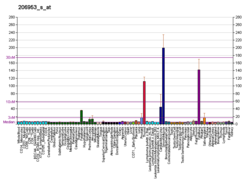Latrofilin 2
Tampilan
Artikel ini sebatang kara, artinya tidak ada artikel lain yang memiliki pranala balik ke halaman ini. Bantulah menambah pranala ke artikel ini dari artikel yang berhubungan atau coba peralatan pencari pranala. Tag ini diberikan pada Oktober 2022. |
Latrofilin 2 adalah protein yang pada manusia disandi oleh gen ADGRL2.[4][5]
Gen ini menyandi anggota subfamili latrofilin reseptor terhubung protein G (GPCR). Latrofilin dapat berfungsi dalam adhesi sel dan transduksi sinyal. Dalam percobaan dengan spesies non-manusia, pembelahan proteolitik endogen dalam GPS yang kaya sistein (situs proteolisis GPCR) menghasilkan dua subunit yaitu fragmen N-terminal dan fragmen C-terminal (subunit dengan kemiripan dengan keluarga sekretin/kalsitonin) dan tidak terikat secara kovalen pada membran sel. Sementara beberapa varian transkrip telah dijelaskan, validitas biologis hanya satu yang telah ditentukan.[5]
Lihat juga
[sunting | sunting sumber]Bacaan lebih lanjut
[sunting | sunting sumber]- Südhof TC (2001). "alpha-Latrotoxin and its receptors: neurexins and CIRL/latrophilins". Annual Review of Neuroscience. 24 (1): 933–62. doi:10.1146/annurev.neuro.24.1.933. PMID 11520923.
- Ushkaryov YA, Volynski KE, Ashton AC (Apr 2004). "The multiple actions of black widow spider toxins and their selective use in neurosecretion studies". Toxicon. 43 (5): 527–42. doi:10.1016/j.toxicon.2004.02.008. PMID 15066411.
- Bonaldo MF, Lennon G, Soares MB (Sep 1996). "Normalization and subtraction: two approaches to facilitate gene discovery". Genome Research. 6 (9): 791–806. doi:10.1101/gr.6.9.791. PMID 8889548.
- Nagase T, Ishikawa K, Suyama M, Kikuno R, Miyajima N, Tanaka A, Kotani H, Nomura N, Ohara O (Oct 1998). "Prediction of the coding sequences of unidentified human genes. XI. The complete sequences of 100 new cDNA clones from brain which code for large proteins in vitro". DNA Research. 5 (5): 277–86. doi:10.1093/dnares/5.5.277. PMID 9872452.
- White GR, Varley JM, Heighway J (Dec 1998). "Isolation and characterization of a human homologue of the latrophilin gene from a region of 1p31.1 implicated in breast cancer". Oncogene. 17 (26): 3513–9. doi:10.1038/sj.onc.1202487. PMID 10030676.
- Kreienkamp HJ, Zitzer H, Gundelfinger ED, Richter D, Bockers TM (Oct 2000). "The calcium-independent receptor for alpha-latrotoxin from human and rodent brains interacts with members of the ProSAP/SSTRIP/Shank family of multidomain proteins". The Journal of Biological Chemistry. 275 (42): 32387–90. doi:10.1074/jbc.C000490200. PMID 10964907.
- Bjarnadóttir TK, Fredriksson R, Höglund PJ, Gloriam DE, Lagerström MC, Schiöth HB (Jul 2004). "The human and mouse repertoire of the adhesion family of G-protein-coupled receptors". Genomics. 84 (1): 23–33. doi:10.1016/j.ygeno.2003.12.004. PMID 15203201.
- Clark TA, Schweitzer AC, Chen TX, Staples MK, Lu G, Wang H, Williams A, Blume JE (2007). "Discovery of tissue-specific exons using comprehensive human exon microarrays". Genome Biology. 8 (4): R64. doi:10.1186/gb-2007-8-4-r64. PMC 1896007
 . PMID 17456239.
. PMID 17456239.
- ^ a b c GRCm38: Ensembl release 89: ENSMUSG00000028184 - Ensembl, May 2017
- ^ "Human PubMed Reference:". National Center for Biotechnology Information, U.S. National Library of Medicine.
- ^ "Mouse PubMed Reference:". National Center for Biotechnology Information, U.S. National Library of Medicine.
- ^ "Genomic structure and expression profile of LPHH1, a 7TM gene variably expressed in breast cancer cell lines". Biochimica et Biophysica Acta. 1491 (1-3): 75–92. Apr 2000. doi:10.1016/s0167-4781(00)00020-8. PMID 10760572.
- ^ a b "Entrez Gene: LPHN2 latrophilin 2".



